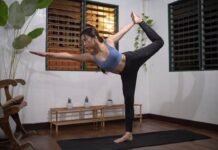Achieving a well-balanced, toned physique is a goal for many fitness enthusiasts, and one of the most efficient ways to get there is through a full body workout with weights. Incorporating weights into your workout routine not only helps build muscle, but also enhances fat loss, improves metabolic health, and strengthens the body in ways that bodyweight exercises alone may not fully accomplish. This guide will walk you through everything you need to know about full body workouts with weights, from the benefits, best exercises, and how to structure your sessions to maximize results.
Table of Contents
- What is a Full Body Workout with Weights?
- Benefits of Full Body Workouts with Weights
- How Often Should You Do Full Body Workouts?
- How to Warm Up for a Full Body Workout
- Essential Equipment for Full Body Weight Training
- Best Full Body Exercises Using Weights
- Squats
- Deadlifts
- Bench Press
- Overhead Press
- Rows
- Lunges
- Dumbbell Snatches
- Farmer’s Walk
- Full Body Workout Routine for Beginners
- Advanced Full Body Workout Routine
- Tips for Progression and Increasing Intensity
- Common Mistakes in Full Body Workouts and How to Avoid Them
- The Role of Nutrition in Strength Training
- The Importance of Rest and Recovery
- Full Body Workouts with Weights for Weight Loss
- Full Body Workouts with Weights for Building Muscle Mass
- Frequently Asked Questions
1. What is a Full Body Workout with Weights?
A full body workout with weights refers to a structured routine that targets all major muscle groups—legs, chest, back, shoulders, arms, and core—during a single training session. The primary objective is to stimulate muscle growth and strength across the entire body, making it a comprehensive workout option for individuals who may not have the time or preference for isolating different muscle groups on separate days (split training).
This type of workout usually incorporates compound movements, which engage multiple muscles and joints simultaneously. These exercises offer a more functional and efficient approach, allowing you to train your entire body in just one session, 2-4 times a week depending on your goals.
2. Benefits of Full Body Workouts with Weights
There are numerous benefits to including full body workouts in your fitness routine:
- Increased Strength: By working all muscle groups, you build overall body strength, improving your performance in daily activities and other fitness-related tasks.
- Efficient Time Use: Instead of dedicating each day to a specific body part, you can train your entire body in fewer sessions each week, making it ideal for busy schedules.
- Balanced Physique: Focusing on every muscle group ensures balanced development, reducing the risk of muscle imbalances, which can lead to injuries.
- Improved Fat Loss: Full body workouts, especially when incorporating weights, have a higher calorie burn. The combination of strength training and cardio-like intensity can boost metabolism, promoting fat loss even after the workout ends (known as the afterburn effect or excess post-exercise oxygen consumption—EPOC).
- Enhanced Functional Fitness: Full body exercises closely mimic movements you perform in daily life, leading to improvements in functional strength and reducing the risk of injury.
- Improved Cardiovascular Health: Compound weightlifting exercises can elevate your heart rate and provide cardiovascular benefits similar to traditional cardio workouts.
3. How Often Should You Do Full Body Workouts?
The frequency of full body workouts depends on your goals and fitness level. Generally, 2-3 full body sessions per week are optimal for most people. This allows enough time for recovery between workouts, which is crucial for muscle growth and preventing overtraining.
For beginners, two sessions per week is a great starting point, while more advanced lifters aiming for hypertrophy (muscle growth) or strength gains might opt for three or four sessions per week, ensuring that they don’t neglect rest days.
4. How to Warm Up for a Full Body Workout
Warming up is a critical aspect of any workout, particularly when lifting weights. A good warm-up prepares your muscles, joints, and nervous system for the intensity of the workout ahead, reducing the risk of injury. Here’s how to effectively warm up for a full body workout:
- Dynamic Stretching: Begin with 5-10 minutes of dynamic stretching to get your blood flowing. This could include leg swings, arm circles, hip openers, and torso twists.
- Light Cardio: Follow with 5 minutes of light cardio, such as jogging, jumping jacks, or cycling, to increase your heart rate and warm up the muscles.
- Warm-Up Sets: Before starting your working sets, perform a few lighter sets of the exercises you plan to do. For instance, if you’re doing squats, start with just the bar or use 50% of your working weight for 1-2 sets of 10-12 reps.
5. Essential Equipment for Full Body Weight Training
For a successful full body workout with weights, you don’t need a full gym’s worth of equipment. However, having access to certain key items will make your workouts more effective and versatile. Here’s a list of essential equipment:
- Barbells: Ideal for compound lifts such as squats, deadlifts, and bench presses.
- Dumbbells: Offer more flexibility than barbells, allowing for a wider range of motion and unilateral exercises (working one side at a time).
- Kettlebells: Excellent for dynamic movements like kettlebell swings and snatches, which can enhance power and stability.
- Weight Plates: Used with barbells, plates come in various sizes and weights, enabling progressive overload in your training.
- Bench: A flat or adjustable bench allows for exercises like bench presses and seated shoulder presses.
- Pull-up Bar: Essential for back and arm exercises such as pull-ups and chin-ups.
- Resistance Bands: These can be used for assistance with bodyweight exercises or to add resistance to weight training.
6. Best Full Body Exercises Using Weights
Now that we’ve covered the basics, let’s dive into the most effective full body exercises. Each of these compound movements works multiple muscle groups simultaneously, ensuring a complete and balanced workout.
Squats
Squats are a foundational exercise in any strength preparing schedule. They primarily target the quads, hamstrings, and glutes, while also engaging your core.
- How to Do It: Stand with your feet shoulder-width apart, holding a barbell across your shoulders or dumbbells at your sides. Lower your body by bending at the knees and hips, keeping your back straight and chest up. Pass through your heels to get back to the beginning position.
Deadlifts
Deadlifts are a full-body movement that targets your hamstrings, glutes, lower back, and even your core and upper body.
- How to Do It: Stand with your feet hip-width apart, with a barbell in front of you. Hinge at the hips, keeping your back straight as you grab the bar. Lift the weight by extending your hips and standing upright, then lower the bar back down with control.
Bench Press
The bench press is a classic upper body strength exercise that basically focuses on the chest, shoulders, and rear arm muscles.
- How to Do It: Lie on a bench with a barbell at chest level. Press the weight up until your arms are fully extended, then lower it back to the starting position, ensuring control throughout the movement.
Overhead Press
This movement targets the shoulders, triceps, and upper chest.
- How to Do It: Stand with your feet shoulder-width apart, holding a free weight at shoulder level. Press the bar directly overhead until your arms are fully extended, then slowly lower it back to shoulder height.
Rows
Rows strengthen your back, shoulders, and arms.
- How to Do It: Bend at the waist while keeping a flat back. Hold a barbell or dumbbells in front of you and row them to your torso, squeezing your shoulder blades together at the top of the movement.
Lunges
Lunges primarily work the legs and glutes, while also engaging your core for stability.
- How to Do It: Step forward with one leg, lowering your hips until both knees are bent at about 90 degrees. Push off with your front foot to return to the starting position, and rehash on the other leg.
Dumbbell Snatches
This dynamic, explosive movement works nearly every muscle in the body, emphasizing power and coordination.
- How to Do It: Begin with a dumbbell on the floor between your feet. In one explosive movement, pull the dumbbell up and overhead, fully extending your arm. Lower it back to the ground and rehash with the other arm.
Farmer’s Walk
The farmer’s walk is an excellent exercise for building grip strength, endurance, and full body stability.
- How to Do It: Hold a heavy weight in each hand (dumbbells or kettlebells), stand tall, and walk forward for a designated distance, focusing on maintaining a tight core and steady posture.
7. Full Body Workout Routine for Beginners
Day 1:
- Squats – 3 sets of 10 reps
- Bench Press – 3 sets of 8 reps
- Dumbbell Rows – 3 sets of
10 reps
- Lunges – 3 sets of 10 reps (per leg)
- Farmer’s Walk – 3 sets of 30 seconds
Day 2:
- Deadlifts – 3 sets of 8 reps
- Overhead Press – 3 sets of 10 reps
- Kettlebell Swings – 3 sets of 15 reps
- Bulgarian Split Squats – 3 sets of 8 reps (per leg)
- Planks – 3 sets of 30 seconds
8. Advanced Full Body Workout Routine
Day 1:
- Barbell Squats – 4 sets of 6 reps
- Deadlifts – 4 sets of 5 reps
- Incline Dumbbell Press – 4 sets of 8 reps
- Pull-ups – 4 sets of 10 reps
- Renegade Rows – 3 sets of 12 reps (per side)
Day 2:
- Power Cleans – 4 sets of 5 reps
- Overhead Press – 4 sets of 8 reps
- Bulgarian Split Squats – 3 sets of 10 reps (per leg)
- Dumbbell Snatches – 4 sets of 6 reps (per arm)
- Hanging Leg Raises – 3 sets of 12 reps
9. Tips for Progression and Increasing Intensity
As you grow stronger and more confident with your full body workouts, it’s essential to keep progressing. Here are some ways to increment the power of your workouts:
- Increase the Weight: Gradually increase the weights you lift to challenge your muscles and promote growth.
- Decrease Rest Times: Shorter rest periods between sets can elevate the intensity of your workout and increase cardiovascular demand.
- Add More Sets or Reps: Aim to do an extra set or add a few more reps to each exercise.
- Incorporate Supersets or Circuits: Performing two exercises back-to-back without rest, or following a circuit of multiple exercises, will keep your heart rate up and add variety to your workout.
10. Common Mistakes in Full Body Workouts and How to Avoid Them
While full body workouts are effective, there are several common mistakes that can limit your progress or increase your risk of injury:
- Neglecting Form: Poor form, especially when lifting heavy weights, can lead to injury. Always prioritize proper technique over the amount of weight you’re lifting.
- Skipping Warm-Up and Cool-Down: Skipping a proper warm-up or cool-down can increase the risk of injury and reduce your performance.
- Not Progressing: Doing the same workout over and over without increasing intensity can lead to a plateau. Regularly adjust your routine for continued progress.
- Overtraining: Full body workouts can be taxing, so ensure you give your muscles enough time to recover. Overtraining can lead to fatigue, injuries, and burnout.
11. The Role of Nutrition in Strength Training
No workout program is complete without proper nutrition. To fuel your full body workouts and ensure muscle recovery and growth, it’s essential to consume a balanced diet rich in protein, carbohydrates, and healthy fats.
- Protein: Protein is vital for muscle repair and development . Aim for 0.7–1 g of protein per pound of the body weight.
- Carbohydrates: Carbs are the body’s primary energy source, especially for high-intensity workouts. Center on complex carbs like whole grains, vegetables, and legumes.
- Healthy Fats: Fats are critical for chemical creation, including the hormones involved in muscle growth. Consolidate sources like avocados, nuts, seeds, olive oil.
12. The Importance of Rest and Recovery
Rest and recovery are just as important as the workout itself. Full body workouts, particularly with loads, place a fundamental proportion of tension on the muscles, and they need time to develop , fix further.
- Sleep: Aim for 7-8 hs of quality sleep per night. Sleep is when the majority of muscle recovery occurs.
- Active Recovery: On rest days, engage in light activities like walking, stretching, or yoga to help reduce muscle stiffness and improve circulation.
- Nutrition for Recovery: After your workout, consume a meal or snack rich in protein and carbs to replenish glycogen stores and aid in muscle recovery.
13. Full Body Workouts with Weights for Weight Loss
Full body workouts are highly effective for weight loss, especially when combined with a calorie deficit. By engaging multiple muscle groups and using weights, you burn more calories both during and after your workout (the afterburn effect).
- High-Intensity Intervals: Incorporate high-intensity interval training (HIIT) into your full body workouts to boost calorie burn.
- Focus on Compound Movements: Compound exercises like squats, deadlifts, and presses work multiple muscles, making them more effective for burning calories than isolation exercises.
- Consistency: For optimal weight loss results, consistency is key. Aim to perform 2-3 full body workouts per week and combine them with a balanced, calorie-controlled diet.
14. Full Body Workouts with Weights for Building Muscle Mass
If your goal is to build muscle mass (hypertrophy), full body workouts can be just as effective as split routines. Here’s how to tailor your full body workout for muscle growth:
- Progressive Overload: Continuously increase the weight you lift or the number of reps/sets you perform to challenge your muscles and promote growth.
- Focus on the 8-12 Rep Range: This rep range is optimal for hypertrophy. Choose a weight that allows you to complete 8-12 reps with good form but feels challenging by the last few reps.
- Sufficient Rest Between Sets: For hypertrophy, rest for 1-2 minutes between sets to allow for partial recovery and ensure you can lift heavy on each set.
15. Frequently Asked Questions
1. Can beginners do full body workouts with weights?
Yes, full body workouts are perfect for beginners as they provide a balanced approach to building strength and muscle across all muscle groups without the complexity of split routines.
2. How long should a full body workout session last?
A full body workout session typically lasts 45-60 minutes, depending on the number of exercises, sets, and your rest periods.
3. Can I do cardio on rest days?
Yes, incorporating light to moderate cardio on rest days can be beneficial for overall fitness, as long as you don’t overtrain.
4. What’s the best way to progress in full body workouts?
The best way to progress is by gradually increasing the weights, reducing rest times, or adding more sets/reps to your exercises. Focus on small, incremental improvements over time.
5. Is a full body workout better than split training?
Both approaches have their benefits. Full body workouts are more time-efficient and great for general fitness, while split training allows for more focus on specific muscle groups.
6. How much weight should I lift in a full body workout?
Pick a weight that challenges you however permits you to maintain proper form. Typically, aim for 70-85% of your one-rep max (1RM) for most exercises.
Conclusion
A full body workout with weights is one of the most effective ways to build muscle, burn fat, and improve overall fitness. Whether you’re a beginner or an advanced lifter, incorporating compound movements and progressive overload into your training can help you achieve a balanced, strong, and healthy physique. Remember to pair your workouts with proper nutrition, recovery, and consistency to maximize results.


